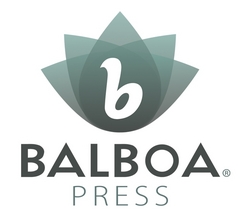YOGA AND GRIEF
And yet, life goes on.
People go to work, bills get paid, and your neighbor still walks his dog each morning at sunrise. We all expect to grieve at some time in our lives. What we cannot prepare for is how we will feel when faced with loss.
Our simple hope in writing this book is to share with you what we have learned to help you take care of yourself based upon our own grief experiences.
~ Gloria and Kathleen
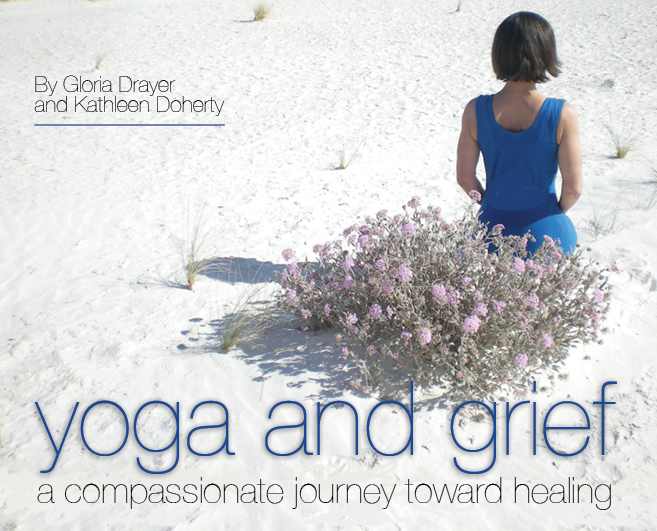
TOOLS FOR COPING WITH GRIEF
MEET THE AUTHORS
Gloria Drayer offers private grief yoga sessions.
These postures consist of a gentle yoga practice that encompasses postures that support the body and spirit during times of loss. Additionally, the grief workshops include journaling, sharing circles, and breathwork. Please contact Gloria if you would like to see this as a workshop offered in the future. Will need to bring to your practice: a yoga mat, a blanket, a journal, an open heart.
Rate: $65 per 60-minute session at Gloria’s location; or $95 per 60 minute session at your location; virtual classes available.
Call 505-275-6638 for an appointment.
Private Sessions are an excellent way to:
- Do yoga in the time and place that works best for you.
- Learn how to develop your own practice.
- Get specially designed practices with your needs and desires in mind.
To rejuvenate your practice – or for beginners to start off with an excellent foundation – a private session is ideal.
Please click here to contact Gloria to set up your private sessions.
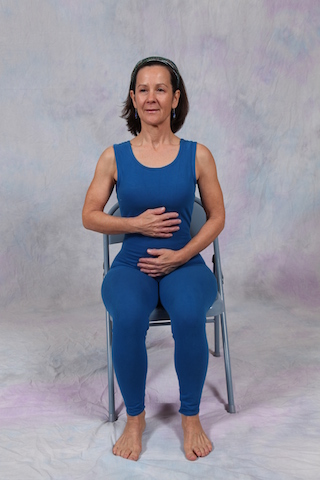
Sit toward the front of the chair with a straight spine. Your back should be a space away from the back of the chair. Place your feet flat on the floor, comfortably apart. If your feet don’t touch the floor, place a folded blanket under them. In all the postures, begin the breath slightly before you start the movement. Take two breaths as you transition from one posture to another.
Abdominal Breath: Note: All breathing is through the nose. Place hands on your abdomen one above the other and inhale the breath deep into your abdomen. On the exhalation, move your navel toward your spine. Repeat six times. When you become more comfortable with all the postures, you may want to practice abdominal breathing throughout this series, remembering to inhale and exhale through your nose.
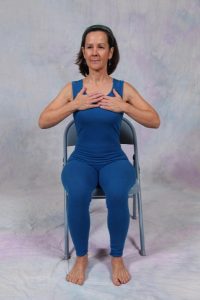

Shoulder Chest Opener:
Start with both hands at your chest. Inhale while slightly lifting your chest as you open your arms out to the side, elbows slightly bent. Exhale while bringing your hands back to your chest. Repeat four to six times.


 Spinal Movements: Come to your hands and knees, shoulders in line with wrists. Use padding for your knees, if necessary. Exhale as you move your hips back towards—but not onto—your heels. As you inhale lead with your chest, moving forward and coming into a slight back arch. Repeat six times.
Spinal Movements: Come to your hands and knees, shoulders in line with wrists. Use padding for your knees, if necessary. Exhale as you move your hips back towards—but not onto—your heels. As you inhale lead with your chest, moving forward and coming into a slight back arch. Repeat six times.


Balancing Posture:
Stand with your hands on the back of a chair. Inhale as you lift your right leg behind you and your right arm overhead having a slightly bent elbow. Exhale to starting position. Alternate sides, and repeat four more times. The last time, hold the posture for three breaths on each side. If you feel steady, you do not need to use the chair.

Legs on Chair: Place your legs on a chair, making sure the backs of your knees are comfortably supported on the chair. Some of you with longer legs may need to put your feet through the back of the chair or turn the chair sideways. Relax your arms by your sides. Inhale as you sweep your arms along the floor overhead with elbows softly bent.

“The soil in which the meditative mind can begin is the soil of everyday life, the strife, the pain, and the fleeting joy. It must begin there and bring order, and from there, move endlessly.”
~Jiddu Krishnamurti Indian philosopher and spiritual teacher
Meditation is another technique we can use to calm the mind and create an inner space where we can be free of worries and discomfort. As with chanting, meditation is an ancient practice that allows us to direct the mind and bring awareness to the present moment. Today, it is taught in a variety of settings from hospitals to corporate retreats as a way to improve focus and foster relaxation and wellness. For some, prayer is also considered a form of meditation.
Why meditate when you are grieving?
In times of grief and stress, you may find yourself lost, unable to keep to a routine and operating mechanically just to get through the day. You may have difficulty sleeping. The source of this stress may come from the past, dwelling on what has been lost, or in contemplating a future that is fearful and unknown. You forget, or maybe never learned, that you can only exist in the present moment. Meditation helps you live in the present by focusing on one moment at a time. It may help you put aside deep and intense emotions — regret, fearfulness, impatience, whatever it may be. If you can sit and ease your mind, relax for a short time, it may be most important thing you do for yourself all day. In and of itself, meditation will not take away the pain, but it may help to ease it. It is not a quick fix, nor a way to anesthetize yourself from grief, but can be a source of peace that will enable you to continue on your journey of healing.
It may be hard to do something good for yourself when you are full of sorrow and sadness; however, this is the time to practice a little loving kindness toward yourself. It may mean that you take one breath and allow yourself to be free from thought for a moment. Perhaps you will be able to do this several times a day as you build mindfulness into your routine. You may have to force yourself at times to “just do it.” You will feel better afterward. On those particular days, you may say, “I don’t have to sit long, but I will sit.”
Meditations
Meditation on the Breath
Meditation for Relaxation

Chanting
Chanting has been employed in nearly every culture and many religions for centuries as a means of increasing consciousness. Because of its repetitive nature, chanting also can be beneficial in bringing focus during times when the mind is agitated or when troubling thoughts consume us. It can redirect our energy from distraction and preoccupation and bring us to a state of tranquility. In addition, the sound of our own voice can be surprisingly reassuring and comforting.
When we say “chant,” we are referring to rhythmic sound in the form of syllables or words. Chanting can be done in any language and may be aligned with any spiritual practice that is important to you. This method of using the voice to focus the mind allows us to be present in the moment. In itself, chanting can invoke a sense of reverence and allow the expression of positive feelings such as praise, gratitude, and wonder.
Benefits
- Expands and lengthens the breath
- Improves concentration
- Calms the mind
- Serves as a tool for spiritual practice/links
- the mind to a higher consciousness
- Balances emotion
Chants
Be Still
Om
Om, Shanti
Peace, Calm, Serenity
Forgiveness Prayer

Gloria Drayer
My mother died of a brain tumor in 2006. When I look back, I know that the grieving began at the time of her diagnosis, more than a year prior to her death. During her illness, my siblings and I were able to participate a lot in her caregiving. We bathed her, fixed her meals, and rubbed her feet – anything to make her feel comfortable. It was natural for me then to turn to my yoga practice to find calm and inner strength. It helped me be centered and connected to my mother’s final needs. I meditated in the morning before she woke up, but often there was not enough time to do a full yoga series, so my practice was simple and restorative. Many days I never got off the floor. I have always adhered to the advice, “Believe in what comforts you.” Yoga kept me calm and healthy. I could just be with my mother and not try to fix or change the situation.

Kathleen Doherty
Ironically, toward the end of our collaboration on this book, I found myself dealing with a catastrophic medical event. I did not have Gloria’s years of experience and discipline to help me face this sudden loss. In basic terms what I needed first was to “just calm down.” I am grateful for the support of family and friends but it was the alone moments, the times when fears loom large and the mind is full of questions for which there are no good answers, that I knew the work on this book was an unexpected gift. I relied mainly on meditation and journaling during my treatment and recovery, and listening to chant is what helped me to sleep at night. As I got stronger I was able to resume yoga and still rely on the gentle practices found in this book.
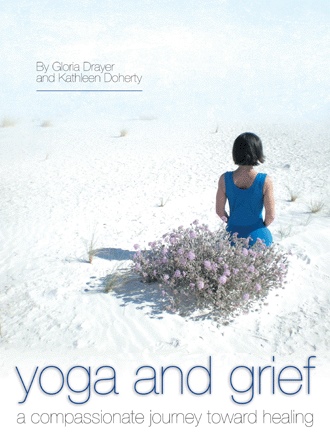
Tester
Testimonials
| “Gloria’s Yoga for Grief class is a treasure. It is a chance to be in a supportive setting with others who are traveling a similar path. The yoga is gentle and the approach is heartfelt. Gloria shapes the class to meet each individual’s needs, relieving any pressure. I took the class about five years ago and found it very helpful. It is healing for the body, mind, and soul. I highly recommend it to anyone grieving a loss.” – JD |
|
Finding a Path through Grief One of the first things I noticed about the book was the gentle, comforting language used. Nowhere do we hear what we must do to assuage our grief. Everywhere we are encouraged to use what works for us, to respect our own needs, to allow ourselves what time we need to heal, despite outside pressure to move on. Most likely, the writers’ own experience and wisdom has guided their supportive tone. Both Gloria and Kathleen came to write this book out of their own experiences of loss: Gloria as she cared for her mother in her last year of life and Kathleen as she faced a major health crisis in her own life. Both talk about using the techniques of yoga described in this book to help them through their own journeys. The writers explain that the suffering of loss unbalances our entire system. By using techniques of yoga we can rebalance the energy of our bodies and minds to find, over time, a sense of calm and peace. This book is remarkable in its breadth, clarity, and accessibility. Strategies offered include breathing techniques, gentle yoga postures, meditation, chant, and the use of ritual. For each of these techniques, several options are offered for their use. For example, in the chapter on yoga postures, there is a practice that can be done in a chair, another done standing, another on the floor, a longer practice, as well as suggestions for rest, so that anyone can find something appropriate. In each chapter, the writers explain the benefits of each technique and offer easy to follow instructions to perform it. To help follow instructions for yoga postures and breathing practices, clear black and white photos supplement the instructions, which are written accurately and simply. To support learning of the chant and meditation, Gloria has recordings of the chants and guided meditations given in the book on her two websites. I highly recommend Yoga and Grief, a compassionate journey toward healing, whether you are dealing with grief right now or not. We all experience losses in our lives, be it the loss of a loved one, the death of a pet, the loss of health, the loss of a relationship, or a job or home, and most of us help others close to us with their losses. To understand the techniques of yoga and how they can support us can be invaluable when we need help. Gloria and Kathleen have created a remarkable resource. It is a gift to those needing a path through grief.” -E. T. YTT |
|
“Three months after my husband’s death. I realized I needed something different in my healing process. I had a good support system of family, friends, and a counselor. I didn’t know exactly what I needed but intuitively I know something was missing. Being a counselor myself I thought about why talking was not enough for me but I let it be. I saw a class offering called “Yoga for Grief” and decided to give it a try even though I had never taken a yoga class. I bought a mat and walked into something that was life-changing for me. I was met at the door by Gloria Drayer and immediately felt her compassion. I knew I would never feel anything other than accepted. It was a quiet class where Gloria gently guided us through the yoga poses. We would end the session by writing. It came to me that it was a beautiful meditation – an opening to my heart self or the part of me that gets away from the chatter of my brain and just “is”. We would end by each person speaking one word. It was powerful. “Yoga for Grief” was the beginning of a never-ending spiritual journey incorporating mind, body, and spirit. Five years later I’m still in class with Gloria.” – AK |
Book Reviews
Julia Lensi on September 29, 2015: Daughter in law (a Yogi) loved it.
Revved Up on May 10, 2015: Very useful
Michelle Bloodworth on April 28, 2015: Beautiful offering for anyone experiencing grief. I highly recommend this book to anyone who is grieving for any reason. I recently lost a parent suddenly. This book is a wonderful support in being present with my grief while helping me to gently regain peace in my life at my own pace, recognizing grief as a process. The text, photographs, and font are all beautiful and peaceful. The authors convey gentleness and compassion throughout the book, covering yoga, as well such as chant, meditation, and ritual. I thank them for creating this book.
Jon M. Aase MD on April 23, 2015: Beautiful offering for anyone experiencing grief. If there were one word to describe this book, it would be “peace”. The text, the photographs, even the typography promote a sense of quiet and calmness. Making no assumptions, the authors offer gentle and compassionate guidance to those who have experienced deep loss, recognizing that grief is not a state but a process. Although the emphasis is upon the self-awareness and release of tension implicit in the practice of yoga, the book also incorporates other healing techniques, including chant, meditation, and ritual. Everything is directed toward the goal of helping the reader regain a sense of direction, balance, and yes, peace in their own lives, at their own pace. I can recommend this book without reservation to those who grieve or who care for others who are grieving.
Patrice Emrie on March 22, 2015: Yoga and this book helped me deal with my grief in a healthy, gentle, and positive approach! The benefits of yoga are many, and I believe this book is one of the best gifts you can give yourself. During a very difficult time in my life (losing my brother in law to a tragic suicide), I bought this book to help me deal with my grief. What I found was a loving way to heal my mind, body, and spirit. Having developed a yoga discipline in my daily life, I have found so many benefits! For me these are sleeping better, decreasing stress, improving my focus, and the ability to deal with my grief in a healthy, gentle, and positive approach. I highly recommend this book to anyone who wants to restore peace in their lives, especially after going through a difficult time in one’s life.
Rita Stafford on March 18, 2015: So helpful, and I’m not grieving, just learning and yoga-ing!
Victoria Sedillo on January 11, 2015: Great book to support yourself through grief. My mother passed away last year and this book has helped me immensely through many moments of grief. I did not sit and read through it cover to cover; but rather randomly open it up and perform whatever appears on the page. The meditations, breathwork, and yoga poses always bring me what I need during an emotional moment. My pain is touched tenderly. Thank you for sharing your journey – may it touch many others. I also really like the format – easy and simple.
Sus Sweeters on December 13, 2014: This has been a lifesaver for me.
JBW on December 6, 2014: Not Just Yoga. Valuable insights into loss, coping and restoring energy into your life. Loss, and the subsequent grief, can be from many things, both subtle and predictable. It could be from being away from home, the end of a friendship, failed dreams, losing your job, aging, in addition to the obvious loss of a loved one. This book isn’t just about yoga, though the poses and breathing techniques are easy to do and very relaxing. But the forward, the notes on grief, and the healing rituals are incredibly valuable reading in their own right. So even if you don’t really like yoga, or you’re just not sure if you like yoga, or even if you truly love yoga, buy this book and start the journey of restoring balance and energy into your life.
Sue Houser on December 1, 2014: The authors approach grief with gentle, easy-to-follow yoga poses, written instructions, and photographs. Whether a person is grieving the loss of a loved one, the loss of a job, or loss of a relationship, this book offers a compassionate healing experience.
Elizabeth M. Heun on November 1, 2014: I am loving your wonderful and inspirational book. It is so personal and accessible. I have never done yoga and find some of the stuff that can be alienating in its lingo and assumptions about your politics. Not so with your lovely pages. So wonderfully practical and teasing in its promises of stolen peace. Thank you for opening up this new avenue for people coping with grief
Kelly on October 12, 2014: Highly Recommended!! This is a warm and compassionate book for anyone dealing with grief. There are wonderful, gentle yoga poses, breathing techniques, and many nurturing suggestions and quotes to help you through difficult times. I highly recommend this book to my family and friends!
Marie A Drayer on August 29, 2014: This book is a wonderful source for each of us. Whether it is from the death of a close friend or a family member, or a loss of a relationship, everyone needs healing. This book is a wonderful source for each of us. I do not practice yoga — and yet I found so much wisdom and comfort from reading the journey of healing from the authors’ perspectives. When experiencing such a profound loss, it is reassuring to know others have not only experienced what you feel but have completed the journey to healing. So, the message is: there is hope for me, too. I absolutely recommend this book; it is a “must-read” for everyone
Elizabeth Lehman on August 3, 2014: Good for daily living too! This wonderful book moves the reader gently through a process of opening and relieving burdens, whether grief, stress, or fatigue. Many of the poses can be done almost anywhere – in the car when rushing to places, in a long and tedious meeting, and when my new dog got out of the yard. I know grief will come my way again, but in the meantime, I find many opportunities to use the wisdom on these pages. Deepest gratitude to the authors for sharing with us.
PURCHASE THE BOOK
In this book, the bereaved will find tools to help in the grieving process. It employs a personal example and a gentle approach to yoga, meditation, and breathing techniques. The content does not rely on yoga-specific language and therefore has a more universal appeal. There is an emphasis on the body-mind connection and the techniques are available to anyone regardless of previous experience. The reader can pick and choose which chapters/techniques work for them. There is an emphasis on positive self-care regardless of where the reader may be in the continuum of grief.
Invite Gloria for Community Talks
Gloria Drayer is available for interviews on the topics of:
- Yoga techniques for the grieving
- Rituals for saying goodbye
- Yoga and breathwork for caregivers
- Transformational grief stories
- The vital purpose of bodywork for emotional healing
- International healing trips and retreats
- The role of chanting in healing grief
- Using mindfulness meditation and mindful living as you are grieving
- Yoga techniques in military settings for post-traumatic stress
- Yoga for children and teens who are grieving
LA YOGA Spotlights the Compassion-based Healing of Yoga and Grief
ALBUQUERQUE, NM – LA YOGA magazine recommends Yoga and Grief: A Compassionate Journey Toward Healing as a resource for those who seek a healthier way to grieve a loss.
The former hospice nurse and yoga teacher Francesca Aster calls the book by Gloria Drayer and Kathleen Doherty a meaningful addition to any yoga teacher’s library and suggests it as a gift for any loved one who is grieving.
The award-winning book combines yoga postures, meditations and breath work with a compassion-based healing approach that speaks about grief in a kind and conscious voice, Aster notes.
“I commend these women for exploring the journey of loss and grief,” she writes, “a subject that is rarely acknowledged in our culture.”
Drayer wrote the book for that very reason. When her mother was dying, she turned to the tools she used as a yoga instructor and retreat leader to get through it. But she noticed a void. “Most people steer away from grief,” she says.
Aster speaks from her perspective as a hospice nurse when she says, “I was humbled to experience the compassion and love put forth so beautifully by these authors.”
Drayer sees the book as a resource for a necessary part of life, not only for those who lose someone through death but those who experience divorce, end of a career or diminishing health as they age. The gentle techniques are available to yogis and non-yogis alike. “Yoga, if we allow it, can release the tension, the grief, the depression in the body, if we allow ourselves to be with it.”

